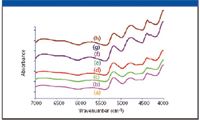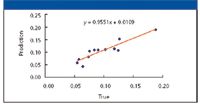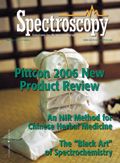Ecdysterone Determination of Niuxi by Near-Infrared Diffuse Reflection Spectroscopy
Here the authors determine the content of ecdsterone in the Chinese herb Niuxi using near-infrared diffuse reflection spectroscopy and the partial least squares correlation. Compared to existing methods, they contend that their approach is easier, quicker, cheaper, and less environmentally harmful.

Niuxi, a Chinese herbal medicine (also named baibei or jijiaogu), refers to the dry root of the plant Achyranthes bidentata Blume (family Amaranthaceae). As one of the traditional Chinese medicines, niuxi has been used commonly for some time. With the flavors of sweet, bitter, sour, and neutral nature, it has been claimed that niuxi reinforces the liver and kidneys and strengthens the tendons and bones. It is said to invigorate blood circulation and eliminate blood stagnation, guiding the blood to go downwards. Thus, it often is used by practitioners of herbal medicine to treat blood stagnation, internal abscess, amenorrhea, hematuria, goiter, arthralgia, pains in waists and knees, lower and upper limb constriction, and other syndromes (1).
To control the quality of niuxi, methods such as colorimetry, thin layer chromatography, supercritical fluid chromatography, and high performance liquid chromatography (HPLC) often are used to determine the content of ecdysterone in niuxi. But all these methods require time-consuming and costly sample preparation involving complicated extraction and purification steps. Therefore, it is highly desirable to develop a new approach that is easier in operation, creates less pollution, and has more rapid detecting speed but without the need for complicated sample preparation.
Near infrared diffuse reflection spectroscopy (NIRDRS) (2) has several advantages as an analysis method, including convenience of operation rapid detecting speed, higher efficiency, lower cost, less pollution, and no complicated preparation procedures (3). In recent years, NIRDRS has been widely applied in the fields of agriculture, food, petroleum, and biochemistry (4). Also, it has been applied successfully in the quality control and analysis of chemical drugs (5,6). However, NIRDRS has been seldom used in the quantitative analysis of active ingredients in traditional Chinese medicine. The present study was initiated in an attempt to determine the ecdysterone content in niuxi with NIRDRS. The data thus obtained were analyzed with partial least squares (PLS), and a satisfying correlation result was observed. Based upon this, the method has been further expanded to perform quantitative analysis of certain active components (flavones and anthraquinones) in large quantities of unknown traditional Chinese medicine.
Experimental
The samples of niuxi were collected from the laboratory of S.-Q. Chen, Henan College of Traditional Chinese Medicine, Henan, China. The samples were dried and comminuted into powders. The powders were then sifted with a 100-eyelet sieve. The sifted powders (3.0 g) were put into a quartz cup mixed uniformly, and planished gently. The samples thus obtained were analyzed using a Spectrum One spectrometer (PerkinElmer, Shelton, Connecticut) equipped with a PbS detector. The scanning condition for the measurement was set at 32 scans with a resolution of 8 cm-1, a scanning range of 10,000–4000 cm-1, and an optical path difference rate of 0.2 cm/s plus 1. Every sample was measured five times, followed by averaging the results. The Quant+ quantitative analysis software (PerkinElmer) for multicomponents was applied to form the mathematical model, based on which the forecasting analysis was performed with the method of principal component analysis (PCA). Many tests were made to find out which frequency range gives the most reliable results. It turned out that the best results were achieved in the 4000–7000 cm-1, where smooth and diagnostic spectra were obtained when the multiplicative scattered correction was made.
Results and Discussion
The spectra of niuxi samples should be obtained in exactly the same operation conditions. In our experiments, the quartz cup was to decrease the signal-to-noise (S/N) caused by the absorption of glasses. The mixed powders were well-proportioned to decrease the dispersion caused by the asymmetric powders. It also was necessary to decrease the subjective errors.

Figure 1: NIRDR spectra of Niuxi produced in different areas: (a) Shandong, (b) Yunnan, (c) Zhejiang, (d) Anhui, (e) Hebei, (f) Jiangsu, (g) Neimeng, and (h) Henan.
The NIRDR spectra of niuxi produced in different areas are shown in Figure 1. Noticeably, all the spectra were similar because niuxi is composed of complex chemical ingredients whose C-H, N-H, and O-H stretches are also in the spectral region of 10,000–4000 cm-1. And the special absorption spectra of the characteristic components in niuxi are covered by the spectra of others such as amylum, fibrin, and amylose. That is why all the spectra are quite similar to each other. However, the component contents in niuxi did vary with different areas because the growing conditions are different from one area to another. Accordingly, the NIRDR spectra can be applied to detecting this kind of derivation and even performing the quantitative analysis. It is essential for mathematical operations of chemistry metrology to reveal the characteristic information concealed in the spectra of samples that cannot be resolved with other routine methods.

Table I: The determined contents of ecdysterone in Niuxi by HPLC (the true values)
The NIRDRS quantitative analysis requires that a model be built with methods of chemistry metrology that can reflect the relationship between the spectra eigenvalue and content of compositions to be determined. To realize this, the first step is to form a component's criterion collection by which the content of the component can be doped in samples (7). The ecdysterone contents in different niuxi samples, which were determined by HPLC as the true contents, were listed in Table I.

Figure 2: The correlation plot between the prediction and true values in the "training collection."
PCA was chosen to perform ecdysterone quantitative analysis (8). We selected 30 stochastic samples which covered the detected content range (0.0364–0.2034%) in 42 samples to form the training collection sets. It is apparent that there is a relationship between the NIRDR spectra and the ecdysterone contents in Niuxi that allows us to build an effective mathematical model, that is, the PLS correlation and prediction method. Accordingly, we simultaneously chose the rational waveband range of 7200–4000 cm-1 to smooth the spectra (nine points), calculate derivative (13 points), and make multiplicative scattered correction, (5300–4200 cm-1), which are the essential pretreatments of the quantitative analysis. The ecdysterone contents of 30 samples in the training collections were determined. The comparison between the prediction and the true values are shown in Figure 2. The deciding coefficient (R-2) was 0.9979, the standard error of estimate (SEE) was 0.002316, and the standard error of prediction (SEP) was 0.003085. The result shows that the model is quite reasonable.

Figure 3: The correlation plot between the prediction and true values in the "predicting collection."
The remaining 12 samples in the collections were used as independent testing samples (9,10) to examine the rationality of the mathematical model. And the results thus obtained are listed in the Table II. The correlation of the prediction and the true values are shown in the Figure 3 (r = 0.9489). As we can see from the figure, there is a strong correlation between NIRDRS and ecdysterone content in niuxi, implying that the method is feasible and quite efficient to determine the ecdysterone content in niuxi.

Table II: The content of edysterone in the "predicting collection"
Conclusions
To stimulate drug development and expedite the course of drug design, many computational techniques have been developed, such as structural bioinformatics (11), molecule docking (12), protein sequence cleavage site prediction (13,14), signal peptide prediction (15,16), enzyme active site prediction (17,18), protein subcellular location prediction (15,19,20), pharmacophore modeling (21), and quantitative structure activity relationships) (22). To expedite the development of Chinese medicine, it is equally important to propose effective mathematical models and introduce new computational methods.
In this study, the content of ecdysterone, which has been regarded as one of the important characteristic components in niuxi, was determined based upon the mathematical model that was established by combining NIRDRS and PLS. The results show that it is a feasible approach to determine chemical component contents in Chinese medicinal materials. Compared with the existing methods for component content determination, the present approach is easier in operation, faster in detecting, creates less pollution, and has higher efficiency and lower cost. It is anticipated that the method will hold great promise for speeding up the development of Chinese herbal medicine.
Acknowledgments
The authors are very much indebted to the two anonymous reviewers whose constructive and knowledgeable comments were very helpful in strengthening the presentation of this work.
D.Q. Wei is supported by grants from Chinese National Science Foundation under the Contract 10376024 and the Tianjin Commission of Sciences and Technology under the Contract 033801911 and special fund for intensive computation. He is also supported by the Virtual Laboratory for Computational Chemistry of CNIC and the Supercomputing Center of CNIC, Chinese Academy of Sciences.
Yan Bai, Dong Wang, Zhen-Xi Yu, Yong Jia, and Feng-Yun Zhu are with the Henan College of Traditional Chinese Medicine, Zhengzhou, China.
Dong-Qing Wei is with the College of Life Sciences and Technology, Shanghai Jiaotong University, Shanghai, China, and the Gordon Life Science Institute, Torrey Del Mar, San Diego, California.
Wei-Zhu Zhong and Kuo-Chen Chou are with the Gordon Life Science Institute, Torrey Del Mar, San Diego, California.
Please direct correspondence to: D.Q. Wei at dqwei@sjtu.edu.cn or K.C. Chou at kchou@san.rr.com
References
(1) Jiangsu New Medical College, Dictionary of Chinese Medicine (Science and Technology Press of Shanghai, Shanghai, China, 1985), pp. 417–420.
(2) K.I. Hildrum and T. Isaksson, Near Infra-red Spectroscopy, Ellis Horwood Series in Analytical Chemistry, T. Naes and A. Tandberg, Eds. (Ellis Horwood, Ltd., U.K., 1992).
(3) J.-G. Wu, C.-T. Chen, Y.-D. Lee, R.-Y. Wang, T.-D. Zhou, and D.-Q. Du, The Technology And Application of Neoteric FTIR Spectroscopy (Science Literature Press, Beijing, China, 1994).
(4) G.-T. Xu, H.-F. Yuan, and W.-Z. Lu, Spectrosc. Spectra Anal. 20(2), 134–142, 1999; E. Peuchant, Appl. Spectrosc. Rev. 26, 227 (1991).
(5) B.-R. Xiang, R. Li, and R.-J. Wu, Computers Appl. Chem. 15, 327–328 (1999).
(6) D.-G. Du, S.-Q. Sun, Q. Zhou, X.-Y. Liang, and X.-R. Yang, Spectrosc. Spectra Anal. 20, 474–476 (2000).
(7) L. Qiao, H.-H. Zhao, and X.-W. Li., Chinese J. Pharm. Anal. 18, 297 (1998).
(8) H.-H. Zhao: Thesis, Agricultural University of China, 1997.
(9) K.C. Chou, Proteins: Structure, Function, Genetics 21, 319–344 (1995).
(10)K.C. Chou and C.T. Zhang, Crit. Rev. Biochem. Mol. Biol. 30, 275–349 (1995).
(11)K.C. Chou, Current Medicinal Chem. 11, 2105–2134 (2004).
(12)K.C. Chou, D.Q. Wei, and W.Z. Zhong, Biochem. Biophys. Res. Commun. 308, 148–151 (2003).
(13)K.C. Chou, J. Biol. Chem. 268, 16938–16948 (1993).
(14)K.C. Chou, Anal. Biochem. 233, 1–14 (1996).
(15)K. Nakai, Adv. Protein Chem. 54, 277–344 (2000).
(16)K.C. Chou, Current Protein Peptide Sci. 3, 615–622 (2002).
(17)A.C. Wallace, N. Borkakoti, and J.M. Thornton, Protein Sci. 6, 2308–2323 (1997).
(18)K.C. Chou and Y.D. Cai, Proteins: Structure, Function, Genetics 55, 77–82 (2002).
(19)K.C. Chou and D.W. Elrod, Protein Eng. 12, 107–118.
(20)K.C. Chou, Proteins: Structure, Function, Genetics 43, 246–255 (2001).
(21)S. Sirois, D.Q. Wei, Q. Du, and K.C. Chou, J. Chem. Infr. Comput. Sci. 44, 1111–1122 (2002).
(22)Q. Du, P.G. Mezey, and K.C. Chou, J. Comput. Chem. 26, 461–470 (2005).
NIR Spectroscopy Explored as Sustainable Approach to Detecting Bovine Mastitis
April 23rd 2025A new study published in Applied Food Research demonstrates that near-infrared spectroscopy (NIRS) can effectively detect subclinical bovine mastitis in milk, offering a fast, non-invasive method to guide targeted antibiotic treatment and support sustainable dairy practices.
New AI Strategy for Mycotoxin Detection in Cereal Grains
April 21st 2025Researchers from Jiangsu University and Zhejiang University of Water Resources and Electric Power have developed a transfer learning approach that significantly enhances the accuracy and adaptability of NIR spectroscopy models for detecting mycotoxins in cereals.
Karl Norris: A Pioneer in Optical Measurements and Near-Infrared Spectroscopy, Part II
April 21st 2025In this two-part "Icons of Spectroscopy" column, executive editor Jerome Workman Jr. details how Karl H. Norris has impacted the analysis of food, agricultural products, and pharmaceuticals over six decades. His pioneering work in optical analysis methods including his development and refinement of near-infrared spectroscopy, has transformed analysis technology. In this Part II article of a two-part series, we summarize Norris’ foundational publications in NIR, his patents, achievements, and legacy.
